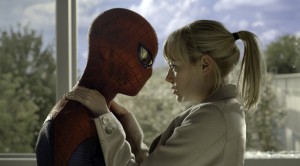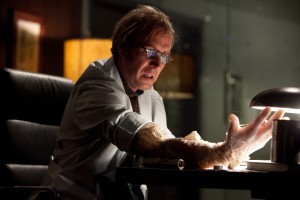
Spider-Man (Andrew Garfield) reveals his secret to Gwen Stacy (Emma Stone) in "The Amazing Spider-Man" (photo courtesy CTMG./ImageMagick)
Though it does seem odd to already be re-spinning the Spider-Man web, there’s not much else to complain about in The Amazing Spider-Man. In theaters July 3, this reboot retells a familiar tale, focusing on different aspects of Peter Parker’s past to give it an entirely different feel than the Sam Raimi trilogy from just a few years ago. And while the origin story is mostly the same, director Marc Webb (whose last name alone could have qualified him to direct this film) seems to be more interested not only in who Peter Parker is, but why he does some of the things he does and, more importantly, why he becomes Spider-Man.
The new Spider-Man is The Social Network‘s Andrew Garfield, whose gawkiness makes the teenage Peter Parker’s awkwardness all the more apparent. But Garfield’s take on Parker is more of a rebellious outcast than a social one. He stands up to the hallway bully, he rides a skateboard and he catches the attention of the equally dorky cutie Gwen Stacy (Emma Stone). The nervous tension between the two is quite adorable, and it only gets more strained when Gwen learns of Peter’s secret.

Dr. Connors (Rhys Ifans) doesn't realize the side effects of the otherwise positive results (photo by Jaimie Trueblood)
But perhaps the most interesting difference between Raimi’s and Webb’s take on Spider-Man is how he comes to acquire his powers. In The Amazing Spider-Man, Parker is trying to find out why his parents left him with his Uncle Ben (Martin Sheen) and Aunt May (Sally Field) at a young age, and why his father’s past is so mysterious. A science wiz himself, Peter uncovers a secret formula his father had come up with that could be incredibly positive or devastating, depending on who else possesses this knowledge. In order to find more answers, Peter tracks down Dr. Curt Connors (Rhys Ifans), a prominent Oscorp scientist who once worked very closely with Peter’s father. It is upon a visit to Oscorp that Peter is bitten by a genetically-enhanced spider (also the result of his father’s previous research). Though Connors seems like a trustworthy person to reveal his father’s secret to, Connors’ interest is not purely professional as it could result in the regeneration of his missing limb. And when Oscorp decides to shut down Connors’ research efforts (while claiming all of his progress as its own), Connors resorts to drastic measures that result in a Godzilla-like rampage through New York City.
Stylistically, The Amazing Spider-Man is just as impressive as Riami’s interpretations, but in very different ways. Spidey’s costume has a more sleek appearance (thanks to Cirque du Soleil designers) and even though there’s no wrestling match against Randy Savage like we saw in Raimi’s first film, Peter’s decision to wear a mask is inspired by luchador imagery. Though all of his powers aren’t genetic this time around (Peter actually makes the wrist-worn web slingers, as was the case in the original comic book story), it is interesting to see Spider-Man’s behavior and mannerisms becoming more and more like those of an actual spider. Webb continues to play on the natural tendencies of spiders, as well as Connor’s lizard-like traits, as much of the action takes place in subterranean sewers (a natural urban habitat for spiders and lizards). But whether it’s underground, on street level or high above New York skyscrapers, The Amazing Spider-Man has some, um, amazing stylistic shots, including some very Nosferatu-like shadow play in the sewers.
To make Parker/Spider-Man’s journey for self discovery all the more complicated, it turns out that Gwen’s father (Denis Leary) is also the police captain who thinks Spider-Man is a menace rather than a hero. But despite Captain Stacy‘s attempted smear campaign, the rest of New York recognizes Spidey’s heroism and rallies behind him in his final battle to save the city (and Gwen) from the Lizard’s evil plot to turn everyone into monsters like the one he has become. Such an empowering gesture is not lost on Peter, an outcast not used to having the support of so many people, especially when he’s dressed in a skin-tight outfit and swinging from skyscrapers and cranes.
The Greek-like comedy and tragedy that have become woven into the Spider-Man mythos remain intact here, and Webb really seems to have fun with the interaction between the characters and Peter’s attempts at understanding and harnessing his newfound powers. None of the characters are completely good or evil, which adds a sense of realism to the otherwise appropriately comic book-y tone. And with a closing-credits hint at who Spider-Man’s next opponent will be, it seems that a new Spider-Man franchise has been born (at least until someone decides it’s time for another reboot or whatever).
The Amazing Spider-Man. Directed by Marc Webb. Starring Andrew Garfield, Emma Stone, Rhys Ifans and Denis Leary. Rated PG-13. www.theamazingspiderman.com.

